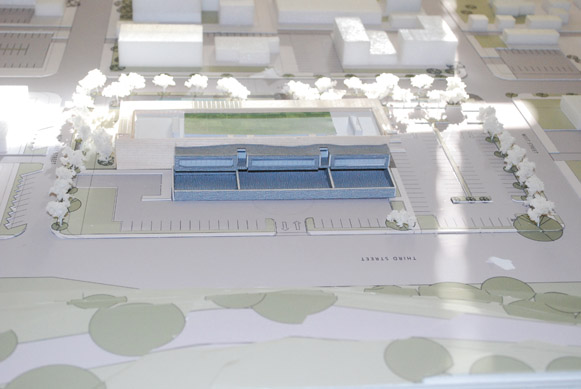
Architects offer the public a look at early renderings
San Benito County residents had a chance to get the first
glimpse of the superior courthouse project that has been years in
the making.
Architects offer the public a look at early renderings
San Benito County residents had a chance to get the first glimpse of the superior courthouse project that has been years in the making.
Two public meetings held June 30 and July 2 offered a chance to residents to ask questions of Smithgroup representatives, the architectural firm handling the design of the courthouse, and offer suggestions.
“It can be a place for the whole community, not just those coming for the courthouse,” said Hiroko Miyake, an associate with Smithgroup.
The courthouse will encompass the block of Fourth Street between Monterey and West streets, where Fremont School used to be. The two-story building will be LEED certified, a standard of building that requires the use of recycled materials and measures that reduce the carbon footprint of the building. It will have a glass façade that faces south to allow in plenty of natural light. It will have a plaza-like area out front that can be used as a gathering spot.
“It was exciting when they [court officials] chose the downtown site versus the airport,” said William L. Diefenbach, a senior vice president with Smithgroup.
Initially it was thought the site may not be suitable for building because of earthquake fault lines. The city of Hollister RDA paid for a seismic study on the site.
“They basically hired geologists to go find faults,” said David Moore, a principal with Smithgroup. “They found features, but no faults. We had state geologists – the best in the world – and they deemed it safe.”
The architectural firm, which is known for institutional projects such as hospitals and public buildings, has worked on other courthouse projects. The courthouse creates a challenge in that they need to balance the functionality and security needs of the building with a design that will reflect the community. The total cost for the 41,500 square-foot project, including design and construction, is estimated at $36.2 million.
“When we do work for the state, it has to be functional,” Moore said. “It’s not an art project … But the projects are very quality-oriented. It will be here for 100 years.”
More than two dozen people showed up for the first public meeting of the week, with a handful of others attending the Thursday meeting, including two state court officials, and some members of the project advisory group, which includes Judges Steven Sanders and Harry Tobias, Gil Solorio, the San Benito County Superior Court executive officer, County Supervisors Reb Monaco and Pat Loe, Susan Thompson, the county administrative officer, Hollister City Councilman Doug Emerson; Hollister City Manager Clint Quilter and San Juan City Councilwoman Priscilla Hill.
“We started about six or seven weeks ago in a process, which will take a year,” Moore said of the design work.
The first part of the design project was to “take a very good, solid analysis of the community,” he said. “We looked at the surrounding area; Park Hill; the community center; shops and commercial; we looked at the civic and institutional buildings.”
The architects plan to keep the many sycamore trees that border the property, and they are looking at other landscape options such as planters to add in more green space to the site. Cherry trees are one option, as well as the idea of row-type plants, to reflect the agricultural roots of the county.
The surrounding neighborhood has an eclectic mix of architecture styles that include everything from Pioneer style, Gothic revival, Craftsman bungalow and Mediterranean revival, among others.
“The site has a very deep history in town,” Moore said. “It was the first site for Col. Hollister’s homestead and then Fremont School.”
In deciding what elements to include in the courthouse site, Diefenbach said, they also looked at what structures have been historically include in other designs. Some of those items include columns, canopies, monuments and platforms.
Some courthouses have “a sense of grandeur purely from the scale,” Diefenbach said, as he showed photos of other courthouses. “Maybe we get that from something else.”
One of the things that the architects and project advisory group agreed on is the idea of transparency. Much of the exterior of the building will be glass, which will help the architects get LEED certification, but will also reflect the desire of court officials to be available to the public. Diefenbach said they are considering a feature wall that would be visible night and day from outside the building, and would go with the craftsmanship and texture of surrounding buildings.
“We felt very strongly that we want people to come in and be able to see, and they took that and really embodied it,” Sanders said.
The design will bring with it new security features. The building will have 30 to 40 security cameras, and detainees will be brought into the back of the structure and into a secure holding area. They will use a separate elevator from the general public, as well.
The first floor of the courthouse will include the self-help center, mediation offices and the court clerk’s office. The second floor will house three courtrooms and a juror assembly room that can be converted to a fourth courtroom in the future if needed. Judges’ chambers of office space will also be on the second floor.
“It is very impressive to watch the process, how it is unfolding,” Loe said. “A LEED building – the first in Hollister that will be silver – says so much about the community and where it is going.”
One thing the architects are looking into that may not make it into the design is the idea of a green roof, with plants growing on top of it. The feature lowers the heat inside of the building during the summer, and would also offer a view for people looking down from Park Hill.
“It used to be a scary idea putting all that dirt on a roof,” Moore said.
The main concern is maintenance and costs for the roof. Construction on the project is expected to begin in February 2011, with completion expected in fall 2012.
“We are hoping to make progress, and shorten up that timeline,” said Jun Quan, the project manager for the state Office of Court Construction and Management. “We are advertising for a construction manager.”









